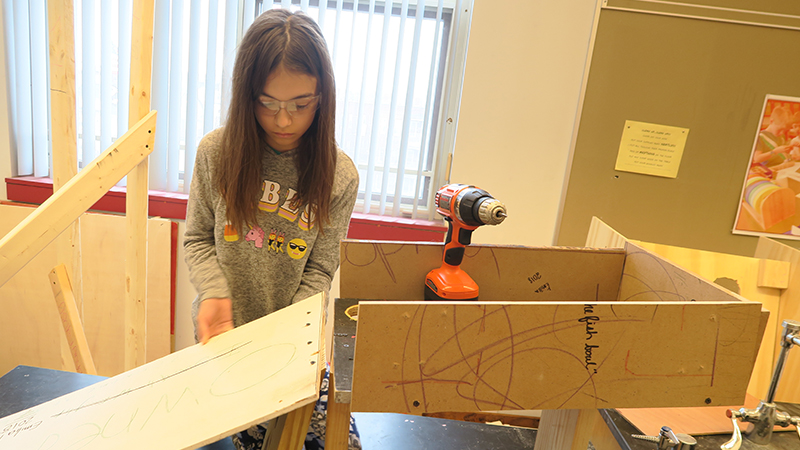Bringing classroom material to life
On a recent morning at the Kennedy School, physical education teacher Mr. Walker could be seen labeling pink sticky notes that he adhered to the gym floor, while hacky sacks intermittently fired in his direction. The sticky notes marked the landing spot for hacky sacks. It was the much-anticipated annual 7th & 8th Grade Engineering Event and the whole school stopped by to see the student-engineered and built machines in action.
The engineering project this year was catapults. Middle Grades Science Teacher Anthony Sharp gave students simple instructions: “Build a machine that stores enough potential energy and converts that energy to kinetic energy to shoot a hacky sack.” Mr. Sharp recommended students research successful catapult designs and that they build small enough projects to maneuver them out the doorway on Catapult Day. A few student teams ultimately had to disassemble and reassemble to get through the door and into the gym, but all teams were able to compete.
Kennedy students worked in teams to create their own orthographic projections, 2D representations of catapults they wanted to build. After working through the engineering design and physics of their catapults, students began a six-week build period in the Kennedy School Makerspace.
Mr. Sharp first introduced catapults about 10 years ago with a marshmallow shooting catapult project. He introduced power tools to the project a few years later as he began to personally acquire them. According to the Massachusetts State Science and Engineering Framework, students should learn the proper use of hand tools and power tools and learn the difference between finishing, fastening or separating a piece of wood. Mr. Sharp learned how to instruct students in safety standards, including always wearing eye protection, and the use of tools like circular saws, power drills and nail guns. When asked her favorite aspect of the project, one student at the event immediately said “working with the tools.” The school recently purchased a table saw and several power drills. Parents and community members generously contributed construction materials for the students and art teacher Jennifer DeAngelis sent over art supplies for decorating final products.

The catapult project teaches students more than just construction skills. Building a catapult requires creativity and problem-solving through cooperative teamwork. Students make mistakes on their own and mostly resolve them on their own. Mr. Sharp intentionally lets students work through issues independently before stepping in with guidance. In return, students enjoy the freedom to apply their classroom knowledge to their projects and the trust that they can handle the tools safely and effectively. Mr. Sharp has been impressed that students continually rise to the challenge. He has even seen students continue the project by building catapults at home.
Catapult Day is the first time students fire their machines, due to space constraints in the Makerspace lab. The day is a celebration of all the students’ hard work, though there was a clear front-runner this year. One team fired a hacky sack right onto the opposite wall of the gymnasium. By the end of the day, the gym floor (and far wall) was swathed in pink sticky notes and excited students. Liaison Francesca Broekman notes that the “K-6 students watch the catapult contest and start thinking about their own designs well before they are in middle school. It generates a lot of anticipation in the younger students for their work on the project.”

R. Ronen, Communications Specialist

